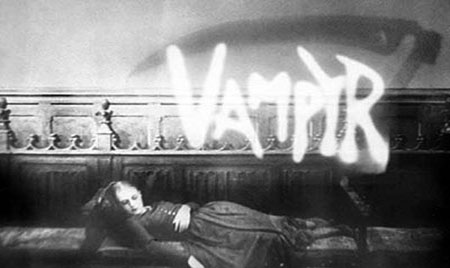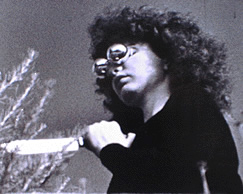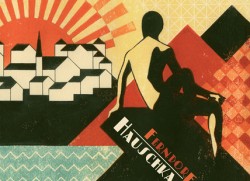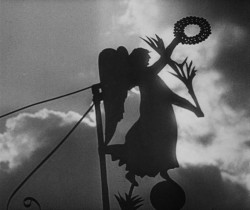
Adam Ryan went to the Howard Assembly Room to check out a fascinating evening of (almost) silent cinema with musical accompaniment: Seaming To Vs Maya Derren’s Meshes of the Afternoon and Hauschka Vs Dreyer’s Vampyr
Once again the Howard Assembly Room has come with the cinematic goods; in September of last year we were treated to a screening of Ozu Yasujiro’s sublime family-melodrama, Late Spring (1949), then early in the year we were treated to Fred Zinneman’s High Noon (1952) accompanied by a set from Western-Jazz band Home of the Brave. On the 19th of last month the recent run of Silent film events – I suspect at least partially prompted by this year’s runaway hit The Artist– continued with Karl Theodor Dreyer’s Vampyr (1932), accompanied by the experimental pianist, Hauschka. Foreseeing a financially bleak month in January, I decided that £10 of my hard-earned post-Christmas ‘pay-cheque’ should go towards a ticket for either High Noon or Vampyr. With no disrespect to Mr Zinneman, my money was immediately put on Hauschka and Dreyer.
I am always a little apprehensive before attending the exhibition of a silent film with live accompaniment. A good film musician can deeply enhance your viewing experience. A bad musician will drive you to distraction. Being unfamiliar with Hauschka or the support act Seaming To – past the fact that Hauschka’s approach is characterised by an experimental, idiosyncratic style of playing a ‘prepared piano’ and that Seaming To has been hailed by Radio 1 as ‘the singer of the 21st century’ – I was harbouring more than a slight seed of scepticism.
 The night kicked off with Seaming To’s innovative, loving accompaniment to Meshes of the Afternoon (1943 d. Maya Derren and Alexander Hammid). I was previously unfamiliar with the film, but found it well and truly fascinating. A surrealist meditation on the nature of dreams, reality and memory, that delves deep into the realms of the unconscious, offering a profoundly disturbing representation of identity and perception. The elliptical narrative follows an unknown woman as she wanders through home and garden in her incessant pursuit of a mysterious, hooded, mirror-faced figure. Each time she fails. The scenario repeats. Space and time become increasingly distorted and certain visual motifs repeat –a key in the palm of her hand, flower petals, mirrors, an off-the-hook telephone, the hooded figure and the ever ominous knife- until the appearance of another figure, an unknown man, seems to normalise the narrative world.
The night kicked off with Seaming To’s innovative, loving accompaniment to Meshes of the Afternoon (1943 d. Maya Derren and Alexander Hammid). I was previously unfamiliar with the film, but found it well and truly fascinating. A surrealist meditation on the nature of dreams, reality and memory, that delves deep into the realms of the unconscious, offering a profoundly disturbing representation of identity and perception. The elliptical narrative follows an unknown woman as she wanders through home and garden in her incessant pursuit of a mysterious, hooded, mirror-faced figure. Each time she fails. The scenario repeats. Space and time become increasingly distorted and certain visual motifs repeat –a key in the palm of her hand, flower petals, mirrors, an off-the-hook telephone, the hooded figure and the ever ominous knife- until the appearance of another figure, an unknown man, seems to normalise the narrative world.
At no point were the film or its accompaniment rendered subservient to the aims of the other. Equipped with synthesizer, Macbook, clarinet and her signature vocal style, Seaming To used a series of haunting, ambient tones as a starting point, slowly and deliberately layering, manipulating and contorting them. Utilising her entire array of instruments to meander in and out of diegesis, she created a wall of sound as fluid and intangible as the film itself, carrying the audience up and down with the pulsing rhythms of the visuals, focussing and implementing us further and further into the images of madness projected onto the screen, hypnotising, transfixing and astounding all present. In short, it was a perfect fusion of image and sound and undoubtedly the finest example of film accompaniment I have ever witnessed.
 Alas, the main event was not quite as spectacular. Hauschka introduced himself with a brief address, detailing his history of working with this particular film, an explanation of his methods and, like any good touring musician, a number of complimentary comments about the locale. The only thing troubling me at this point was his comment: “I hope the film works with my music.”
Alas, the main event was not quite as spectacular. Hauschka introduced himself with a brief address, detailing his history of working with this particular film, an explanation of his methods and, like any good touring musician, a number of complimentary comments about the locale. The only thing troubling me at this point was his comment: “I hope the film works with my music.”
The quality of the film itself goes without question. Dreyer, although somewhat neglected at times in critical discourse, is arguably one of the greatest – and indeed most influential – filmmakers of all time, and Vampyr is among his finest works. It should be noted that the film isn’t actually silent. To facilitate the studio requirement that the film be shot in three different languages Dreyer stripped back dialogue to its bare minimum and used inter-titles. Only the German language version still exists (available on an excellent ‘Masters of Cinema’ release).
The film follows Alan Gray, a young man with an interest in all things ‘Fantastic,’ whose fascination with ghouls, ghosts and – predictably – vampires leads him to Courtempierre, a town well known for its supernatural activities. During his first night an unknown man visits him in a dream, leaving him a mysterious package marked ‘To be opened upon my death.’ When he awakes, the package remains. He sets out to find the man, and stumbles across a dark secret.
 Sounds like a straightforward vampire movie right? If only it were that simple; along with Jack Clayton’s The Innocents (1961), this is arguably the finest filmic example of a Todorovian ‘Fantastic,’ a sub-genre of ‘fantasy’ characterised by hesitation between “a natural or supernatural explanation of the events described.” Switching between Gray’s perspective and our own viewpoint, doubt is cast incessantly upon the events depicted, maintaining confusion to the bitter end. The sequence in which Gray splits into two translucent figures is particularly effective in this sense: we both witness, and experience his burial, all the time aware that half of his self is laid on a bench not far from the grave. Are we really seeing our protagonist being buried alive, or is it just a dream? The decisive use of montage, flawlessly choreographed camera movement, and masterful mise-en-scene all work together to create an intense ambiguity and subtlety of mood rarely seen in cinema.
Sounds like a straightforward vampire movie right? If only it were that simple; along with Jack Clayton’s The Innocents (1961), this is arguably the finest filmic example of a Todorovian ‘Fantastic,’ a sub-genre of ‘fantasy’ characterised by hesitation between “a natural or supernatural explanation of the events described.” Switching between Gray’s perspective and our own viewpoint, doubt is cast incessantly upon the events depicted, maintaining confusion to the bitter end. The sequence in which Gray splits into two translucent figures is particularly effective in this sense: we both witness, and experience his burial, all the time aware that half of his self is laid on a bench not far from the grave. Are we really seeing our protagonist being buried alive, or is it just a dream? The decisive use of montage, flawlessly choreographed camera movement, and masterful mise-en-scene all work together to create an intense ambiguity and subtlety of mood rarely seen in cinema.
It is in reflecting these nuances and transitions where Hauschka unfortunately fell down. Although he was approximately on the button, I never quite felt as gripped as I perhaps should, especially considering the material he had to work with. Rhythmically he seemed to have little range – perhaps a slightly misplaced attempt to work with the rhythm of the visuals – with little more to offer melodically. What did impress me was the range of timbres he managed to coax out of the instrument; its open belly displayed a whole range of inanimate objects (such as spoons, ping pong balls and many others), each endowing the overall aesthetic with a peculiar – but by no means unpleasurable – character. Had the arrangement been a little less self-serving and Hauschka more familiar with the film itself it would have been the ideal accompaniment as it never detracted from my enjoyment per se, there was just a certain lack of co-operation on the side of the soundtrack.
All in all though, the night was a great success. Judging from the general buzz before and after it had been a revelation to many, whether in regards to the films themselves or, like myself, the musical talent. It seems my initial assertion is true: the Howard Assembly Room has indeed come with the cinematic goods and I for one will be keeping a close eye on any future offerings they may present us with.
If you were unlucky enough to miss this particular event, Vampyr is showing at Hebden Bridge Picture House on 23rd February, again with live accompaniment, but this time from Steven Severin. Check the details here.
Adam Ryan is currently programming a day of Polish cinema for community film society Minicine. The event will be held on the 7th April at the Polish Parish Club in Bradford. See minicine.org.uk or follow on Twitter @miniminicine for more information as it is announced.
Mike McKenny is The Culture Vulture’s film editor. If you have any film related stories, articles, reviews with a twist, etc, contact him on mike.mckenny1983@gmail.com or find him on Twitter @DestroyApathy
This is an evocative piece of writing, makes me sad I’ve missed the second showing. seaming to sounds just enchanting. Looking forward to the Polish event.
Many thanks! It seems the recent run of Vampyr is over, but word on the street is that Dreyer’s ‘The Trial of Joan of Arc’ is going to get a re-release in cinemas; now that will be something not to be missed
*’Passion of Joan of Arc’